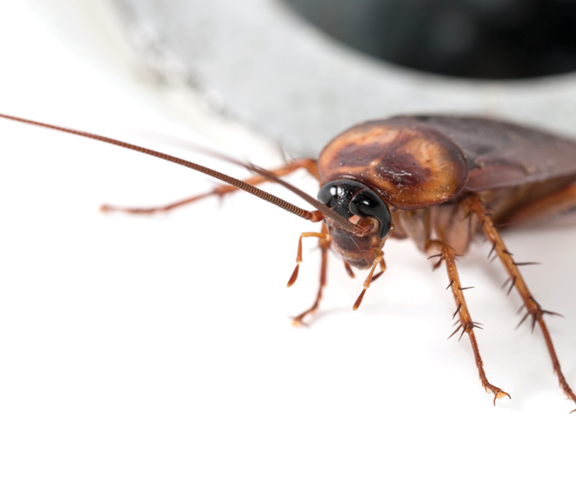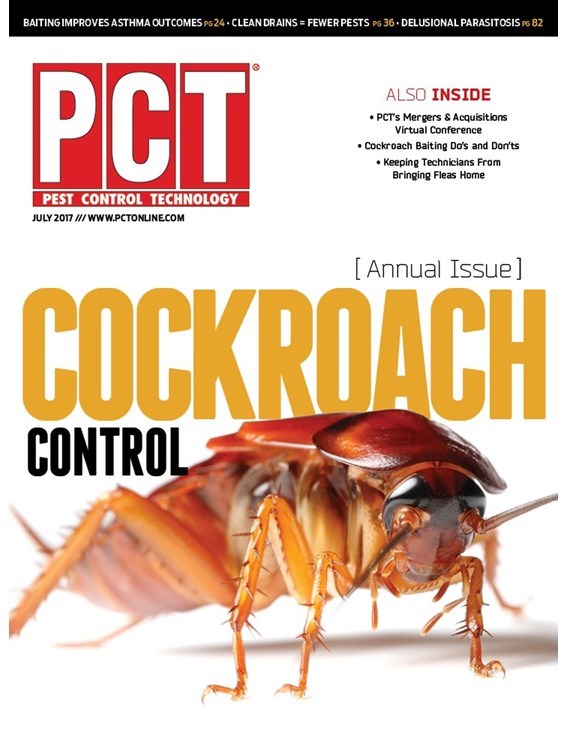By Lisa Lupo

Editor’s note: The following article originally appeared in the January/February 2017 edition of GIE Media’s Quality Assurance & Food Safety magazine.
Drain sanitation is a common problem in food facilities, but did you know that cockroaches can live in drains, feed on the gunk that builds up, and enter your customers’ plants to contaminate food and food surfaces?
“Cockroaches often live in the sewer system so they can travel up into facilities from there, but they can also enter drains from the facilities themselves,” explained Rockwell Labs Owner/President Cisse Spragins. “Roaches need moisture, food, and non-freezing temperatures, and drains generally provide all three.”
Cockroaches can enter facilities in other ways as well, said Nisus National Technical Director and Entomologist Reid Ipser. They can enter from outdoor areas, particularly from trash receptacles and adjacent businesses that exhibit poor sanitation levels; they can be unknowingly introduced through packaging and containers; and they can use drain lines as conduits from outside harborage areas and/or from interconnecting sewer systems.
Once introduced, they can be allowed to breed and fester due to poor sanitation practices. For cockroaches, Ipser said, “Drains serve as a nice, cool, restful place to breed, eat food-stuffs and harbor for protection.”
American cockroaches tend to be the most problematic species in relation to drains, with Orientals a problem in some geographic areas, and German cockroaches also having a tendency to be attracted to drains. German cockroaches are more likely to move in and out, rather than harboring in the drains. But, said Diversified Sales and Marketing Technical Consultant Carl Forehand, “If they come in other ways, they can be attracted to drains if they are not clean.” Additionally, he said, drains can be conducive to any insect activity if they are not regularly being cleaned; if food particulates are allowed to get into them; if they get wet, then dry out; etc.

But regardless of the species, how the cockroaches enter the facility, or what attracts them to drains, they are an issue. “Once in a facility and moving around, they can carry disease, and if someone eats a product contaminated with fecal matter, it can cause asthma, dysentery, salmonellosis, etc.,” Forehand said.
“As roaches move across food contact surfaces from drains and possibly sewers they can spread pathogens,” Ipser said, adding that FDA estimates that 48 million people are struck with foodborne illness each year.
As such, cockroaches are a public health pest, particularly in food facilities, Spragins said. “Their feces, sputum, and the insects themselves, or their parts that get into food, can transmit disease. Infestations also negatively affect employee morale and the general image a facility projects to employees, vendors, customers and other visitors.”
FSMA COMPLIANCE. Cockroach presence could cause issues with performance standards and produce safety sections of the Food Safety Modernization Act (FSMA). But, Ipser said, “it is not just FSMA; infestations are a violation of the Good Manufacturing Practices.”
As Spragins explained, “FSMA calls for implementing proactive measures to prevent food contamination, and pest management is a central tenet of such a program. It is impossible to prevent food contamination if insects are roaming freely within a facility. The biofilm that builds up in drains is well-known to harbor noxious bacteria. Roaches (or flies) going from drains to food contact surfaces can transmit these pathogens throughout a facility.”
It is for this reason that PMPs servicing food plants and in-house pest control personnel at these facilities must be well versed in FSMA rules to ensure they are maintaining a safe environment, Forehand said. “Everyone in the facility should be familiar with FDA and FSMA rules. Auditors also come in looking for issues, so the facility needs to be in compliance.”
This is true whether the facility performs its own pest control or contracts with a third-party service provider. If contracting the service, he said, the pest management professional needs to perform a thorough inspection, not just a walk-through, and then offer solutions to take care of the problem and treat for the insect infestation. Then he or she needs to follow-up to ensure the problem is solved — and to make sure it hasn’t popped up elsewhere. “One of the biggest things we fail in is communication, and that’s a two-way street,” Forehand said.
If a facility conducts its own service, all employees need to understand the process, Forehand said. “Everyone needs to be in on the program, not just the one person.” For example, a facility may want to post rules on a wall, similar to the way handwashing signs are posted.
Additionally, everyone in the facility should be familiar with the purpose and requirements of FSMA, including the answers to questions such as: What hazards exist? What are the solutions?
SOLVING DRAIN ISSUES. Whether the cockroaches are coming into the facility through drains or going to drains after they come in through other means, there are a number of solutions PMPs can employ to eliminate the cockroaches and reduce drain attraction.
As provided by Spragins, Ipser, and Forehand, such solutions include:
1. Exterior Treatments. Proactive perimeter pest control is necessary, including habitat reduction around the outside perimeter, a barrier spray on the foundation and around entry points, and a band of moisture-resistant granular bait applied outside the spray barrier. Always read the label to determine what products can be used and where.
2. Drain Cleaning. Manually cleaning drains can be helpful, but be mindful of the fact that scrubbing, steaming, pressure washing, etc., can aerosolize pathogenic bacteria and potentially transmit them onto food or food processing surfaces. Bio-sanitation products can effectively clean drains in environments with chronic moisture and high organic load, and can help keep drains clean by digesting organic build-up in which both pests and pathogens can harbor. Maintaining drain cleanliness and using foam cleaners also can provide continued pest suppression. Regular use of any cleaner is very important, as even those that don’t kill the insect will remove the conditions conducive to insect breeding.
3. Drain Treatments. Some pesticides can be used in and around drains, but many cannot, so read labels before applying. If there is any movement in the drain, especially if water is flowing, be careful about chemical use; ensure that you don’t contaminate groundwater or areas where water drains out (such as into an open stream).
4. Drain Traps. Traps in drain lines need to be installed and working properly to help prevent roaches from entering drains and coming into the facility through the sewer or outdoor water treatment facilities. The water trap seal valve sits in the drain, letting water flow out, but not allowing insects to move up into the facility. The traps also can eliminate gasses and odors that can come up through drains and attract insects.
5. Interior Inspections. Regular and thorough inspections of the areas adjoining drains will reveal whether the drain program is effective. Cockroaches can harbor in tight spaces under and behind equipment, in stainless steel table legs, behind and under cracked tile, and in wall voids that are accessible through plumbing and utility penetrations. Inspect these areas for cockroaches as well. If needed, deploy a baiting program throughout the facility, as permitted by regulation.
There are a lot of problems created in drains, Forehand said, so it is important that facilities conduct inspections and eliminate conducive conditions. “Be familiar with and knowledgeable about what it takes to keep those problems from occurring,” he said. “It takes a continuous effort to maintain drain sanitation,” Ipser said. “Clean drains equal fewer pest issues.”
The author is Editor of QA magazine. She can be reached at llupo@gie.net.

Explore the July 2017 Issue
Check out more from this issue and find your next story to read.
Latest from Pest Control Technology
- SiteOne Hosts 2024 Women in Green Industry Conference
- Veseris Celebrates Grand Reopening of the Miami ProCenter
- Rollins' 2024 Second Quarters Revenues up 8.7 Percent YOY
- Fleetio Go Fleet Maintenance App Now Available in Spanish
- German Cockroach Control Mythbusting
- Total Pest Control Acquires Target Pest Control
- NPMA Workforce Development Shares Hiring Updates
- Certus Acquires Jarrod's Pest Control





